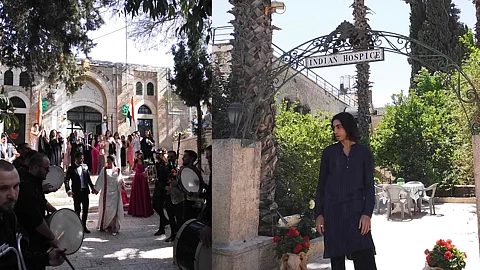
- HOMEGROWN WORLD
- #HGCREATORS
- #HGEXPLORE
- #HGVOICES
- #HGSHOP
- CAREERS
- ABOUT US
- CONTACT US

Raised by the historical roots of Jerusalem, Palestine, surrounded by the walls of the Indian Hospice. A 900-year-old sanctuary nestled within the Old City, it is just minutes from Al-Aqsa Mosque, the Church of the Holy Sepulchre, and the hub of the Armenian Quarter. Living a life that was within the past and future. Each corner rang with memory, each corridor perfumed with spice, prayer, and time. And yet, in the midst of all this anchorage, identity, for me, was never a walk in the park.
My family hails from Saharanpur, Uttar Pradesh. My great-grandfather, Nazir Hasan Ansari, was posted to Jerusalem in 1924 to look after the Indian Hospice and its spiritual responsibilities. And since then, the Ansari family generations have lived there as guardians of a holy cultural bond between India and Palestine. Though I was brought up within Arab Traditions, my origins were unquestionably Indian. But being Palestinian-Indian wasn't always a poem. I didn't know Hindi or Urdu. I didn't behave entirely Palestinian. My identity was questioned too often — not quite enough of either, never quite the other.
Yet, while I may have been short on linguistic skills, I compensated with an eye for culture. Being raised in the Old City meant being immersed in art, even within the seemingly mundane — mosaic tiles, olive wood trim, wedding drums, market pandemonium, embroidered thobes, za'atar-selling old women by the handful. Everything was layered, textured, alive. That context formed creativity. It made me curious, detail-sensitive, and enamoured by beauty. Eventually, that attraction brought me to India. Not only to reconcile with the half of me I didn't know growing up, but to make a career in fashion, modelling, and styling.
Delhi has been an odd, slightly surreal homecoming of sorts. I find myself time and again surprised by the similarity between India and Palestine, despite being worlds apart. We’re both loud and loving, bound by deep respect for elders, obsessed with food, and, most profoundly, connected to the land. Both sides of my family come from generations of farmers. That relationship with the earth: growing things, feeding people, finding joy in harvests — is something that lives quietly in my bones.
When I went back to Palestine recently, I wanted to pursue these unseen connections using imagery. So I set out to photograph whatever made me feel suspended between the two worlds. What Palestine whispered, India echoed back.
Spices stacked high at a stall in the Old City — the colours and the scents — they immediately took me to the street-side spice stalls of Delhi. There’s an image of Jerusalem’s old walls, aged and sun-soaked, that looks eerily similar to the forts I’ve seen in Rajasthan. One of my favourite shots is of a souvenir bag printed with elephants that says ‘Jerusalem’ on it. It’s a hilarious and bizarre contradiction, because there are no elephants in Palestine. It’s kitsch, but it says something about the quiet ways in which our worlds collide.
And then there's the wedding photo: a procession of Palestinian drummers escorting a bride into celebration, something immediately reminiscent of Indian baraats. Naturally, there’s also the cuisine, tiny plates of hummus, olive oil, dips, and warm bread. Not so different from Indian food consumed with rotis, passed around from the middle of the table. I even took a picture of a vegetable vendor, his stall nearly the same as the ones I walk past in Delhi daily.
All of these images became more than moments: they became mirrors. They made my identity whole.
Professionally, I've attempted to let that identity be my guide. As a model, stylist, and writer, I treat fashion like a mode of storytelling, using clothing, moods, and movement to convey what words so often can't. In a business culture consumed by freshness, algorithms, and transitory attention spans, it is simple to wonder if your image has an expiration date. Models become vessels, not voices. But I want to be more than a face. I envision modelling as a platform, an opportunity to share my heritage, to bridge cultures, to create a bridge between backgrounds that are otherwise left behind in the ever-evolving story that is fashion.
It's unusual to be a Palestinian model, and to be a Palestinian-Indian one is even more so. That uniqueness can be pressure, yes, but it can also be power. I embody both cultures imperfectly, but with pride. I work with textures, fabrics, and silhouettes that address both homes. In modelling, I am duality, balance, and contradiction all at once. And in it all, I want to demonstrate that identity need not be clean or singular to be true. Often, it is the in-between that is most true.
About The Author
Faris Ansari is a Palestinian-Indian Model, stylist, and creative. His work often merges fashion, photography, and storytelling to explore questions of cultural recollection, identity, and belonging. He was raised in Jerusalem's ancient Indian Hospice. And now has been living and working in Delhi for almost four years, contributing to various facets of diverse creative fields.
You can follow him here.
